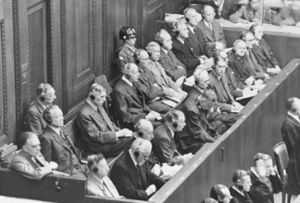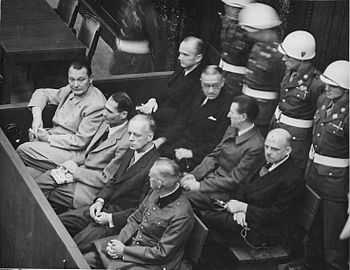IG Farben Trial

The United States of America vs. Carl Krauch, et al., also known as the IG Farben Trial, was the sixth of the twelve trials for war crimes the U.S. authorities held in their occupation zone in Germany (Nuremberg) after the end of World War II.
The twelve trials were all held before U.S. military courts, not before the International Military Tribunal, but took place in the same rooms at the Palace of Justice. The twelve U.S. trials are collectively known as the "Subsequent Nuremberg Trials" or, more formally, as the "Trials of War Criminals before the Nuremberg Military Tribunals" (NMT). The IG Farben Trial was the second of three trials of leading industrialists of Nazi Germany for their conduct during the Nazi regime. (The two other industrialist trials were the Flick Trial and the Krupp Trial.)
The defendants in this case had all been directors of IG Farben, a large German conglomerate of chemical firms. The company had been a major factor already in World War I, when their development of the Haber-Bosch process for nitrogen fixation compensated for Germany's being cut off from the Chilean nitrate trade and allowed IG Farben to produce synthetic nitrate and extract and process nitrogen for use in agricultural fertilizer. (Nitrate is an important component for the fabrication of explosives such as gunpowder, dynamite or TNT.) In World War II, Degesch (42.5 per cent owned by IG Farben) was the trademark holder of Zyklon B, the poison gas used at the extermination camps.[1] IG Farben also developed processes for synthesizing gasoline and rubber from coal, and thereby contributed much to Germany's ability to wage a war despite having been cut off from all major oil fields. The charges consequently centered on preparing to wage an aggressive war, but also on slave labor and plundering.
The judges in this case, heard before Military Tribunal VI, were Curtis Grover Shake (presiding judge), former Chief Judge of the Supreme Court of Indiana; James Morris from North Dakota; Paul M. Hebert, dean of the Law School of the Louisiana State University; and Clarence F. Merrell, a lawyer from Indiana, as an alternate judge. The Chief of Counsel for the Prosecution was Telford Taylor. The indictment was filed on May 3, 1947; the trial lasted from August 27, 1947 until July 30, 1948. Of the 24 defendants arraigned, 13 were found guilty on one or the other counts of the indictment and sentenced to prison terms ranging from one and one half to eight years, including time already served; ten defendants were acquitted of all charges. Max Brüggemann (Farben's chief legal advisor) was removed from the trial and his case discontinued on September 9, 1947 due to medical reasons.
Indictment
- Planning, preparation, initiation, and waging of wars of aggression and invasions of other countries.
- War crimes and crimes against humanity through the plundering and spoliation of occupied territories, and the seizure of plants in Austria, Czechoslovakia, Poland, Norway, France, and Russia.
- War crimes and crimes against humanity through participation in the enslavement and deportation to slave labor on a gigantic scale of concentration camp inmates and civilians in occupied countries, and of prisoners of war, and the mistreatment, terrorization, torture, and murder of enslaved persons.
- Membership in a criminal organization, the SS.
- Acting as leaders in a conspiracy to commit the crimes mentioned under counts 1, 2, and 3.
All defendants were indicted on counts 1, 2, 3, and 5. Only Schneider, Bütefisch, and von der Heyde were charged on count 4, "Membership in the SS". The SS had been declared a criminal organization previously by the IMT.
Despite the extensive evidence presented by the prosecution that showed that the company had been deeply involved in Germany's rearmament after World War I from the onset, the tribunal rejected the charges for preparing an aggressive war and for conspiracy to that end. On count three ("slave labor"), the judgement "allowed the defendants the benefit of the defense of 'necessity'" (Telford Taylor, "The Nuremberg War Crimes Trials"; International Conciliation, No. 450, April 1949). Only in the case of Auschwitz, where IG Farben had constructed a plant next to the concentration camp with the clear intent to use inmates as slave workers, did the tribunal consider the evidence sufficient to prove that IG Farben acted on its own initiative. The tribunal concluded that the defendants could be held responsible only for this one case.
Judge Hebert filed a dissenting opinion, in which he argued that the defense of "necessity" did not apply and that all defendants should have been found guilty on count 3 of the indictment. He stated that:
- "...the record shows that Farben willingly cooperated and gladly utilized each new source of manpower as it developed. Disregard of basic human rights did not deter these defendants." —[2]
- "Willing cooperation with the slave labor utilization of the Third Reich was a matter of corporate policy that permeated the whole Farben organization... For this reason, criminal responsibility goes beyond the actual immediate participants at Auschwitz. It includes other Farben Vorstand plant-managers and embraces all who knowingly participated in the shaping of the corporate policy." —[3][4]
Judge Hebert filed his statement on December 28, 1948, nearly 5 months after the judgment.
Defendants
| Name | Photo | Function | Charges | Sentence | ||||
|---|---|---|---|---|---|---|---|---|
| 1 | 2 | 3 | 4 | 5 | ||||
| Carl Krauch | Chairman of the Supervisory Board; member of Göring's Office of the Four-Year Plan |
I | I | G | I | 6 years, including time already served; died 1968 | ||
| Hermann Schmitz | Chairman of the Managing Board (CEO); member of the Reichstag |
I | G | I | I | 4 years, including time already served; died 1960 | ||
| Georg von Schnitzler | Wehrwirtschaftsführer (Military Economy Leader); Captain in the SA |
I | G | I | I | 2½ years, including time already served; died 1962 | ||
| Fritz Gajewski | Director of AGFA | I | I | I | I | acquitted; died 1962 | ||
| Heinrich Hörlein | Head of chemical research | I | I | I | I | acquitted; died 1954 | ||
| August von Knieriem | Chief Counsel; Head of the legal department | I | I | I | I | acquitted; died 1978 | ||
| Fritz ter Meer | Head of dept. II, which was in charge of the chemical plant in Buna near Auschwitz |
I | G | G | I | 7 years, including time already served; died 1967 | ||
| Christian Schneider | Head of dept. I, in charge of nitrogen and gasoline production; head of personnel dept., "supporting member" of the SS |
I | I | I | I | I | acquitted; died 1972 | |
| Otto Ambros | Head of the chemical warfare committee at the war ministry; production chief for Buna and Auschwitz |
I | I | G | I | 8 years including time already served; died 1990 | ||
| Max Brüggemann | Plant leader | I | I | I | I | Removed from trial due to medical reasons | ||
| Ernst Bürgin | Plant leader | I | G | I | I | 2 years including time already served-died 1966 | ||
| Heinrich Bütefisch | Production chief at Auschwitz, Obersturmbannführer in the SS | I | I | G | I | I | 6 years including time already served; died 1969 | |
| Paul Häfliger | Head of the metals department | I | G | I | I | 2 years including time already served-died 15 Nov 1950 | ||
| Max Ilgner | Head of intelligence and propaganda | I | G | I | I | 3 years including time already served; died 1966 | ||
| Friedrich Jähne | Chief engineer | I | G | I | I | 1½ years including time already served; died 1965 | ||
| Hans Kühne | Plant leader | I | I | I | I | acquitted; died 1969 | ||
| Carl Lautenschläger | Plant leader | I | I | I | I | acquitted; died 1962 | ||
| Wilhelm Rudolf Mann | Pharmaceuticals; member of the SA | I | I | I | I | acquitted; died 1992 | ||
| Heinrich Oster | Manager of the Nitrogen Syndicate | I | G | I | I | 2 years including time already served; died 1954 | ||
| Carl Wurster | Plant leader | I | I | I | I | acquitted; died 1974 | ||
| Walter Dürrfeld | Head of construction at Auschwitz plant; head of construction at Monowitz (Auschwitz III) |
I | I | G | I | 8 years including time already served; died 1967 | ||
| Heinrich Gattineau | Intelligence and plant police | I | I | I | I | acquitted; died 1985 | ||
| Erich von der Heyde | Deputy of intelligence and plant police; Hauptsturmführer in the SS, member of the OKW |
I | I | I | I | I | acquitted-died 1984 | |
| Hans Kugler | Head of sales for dyestuffs for south-eastern Europe | I | G | I | I | 1½ years including time already served. Died 1968 | ||
I — Indicted G — Indicted and found guilty
The defendants Ilgner and Kugler were released immediately after the judgement since they had already been in custody longer than their sentence.
References
- ↑ Hayes, Peter (2004). From Cooperation to Complicity: Degussa in the Third Reich. Cambridge; New York; Melbourne: Cambridge University Press. p. 279. ISBN 0-521-78227-9.
- ↑ "The Mazal Library". Mazal.org. Archived from the original on 2012-07-17. Retrieved 2013-01-05.
- ↑ "The Mazal Library". Mazal.org. Archived from the original on 2012-07-17. Retrieved 2013-01-05.
- ↑ "The Mazal Library". Mazal.org. Archived from the original on 2012-07-17. Retrieved 2013-01-05.
External links
- Trial proceedings from the Mazal Library.
- Description from the U.S. Holocaust Memorial Museum.
- Another description
- The Authentic Records from the Nuremberg Tribunal Against the Oil and Drug Cartel
- The “relay of life” to the next generation - IG Farben connection
| ||||||||||||||||||||||||||||||||||||||||||
| |||||||||||||||||||||||
